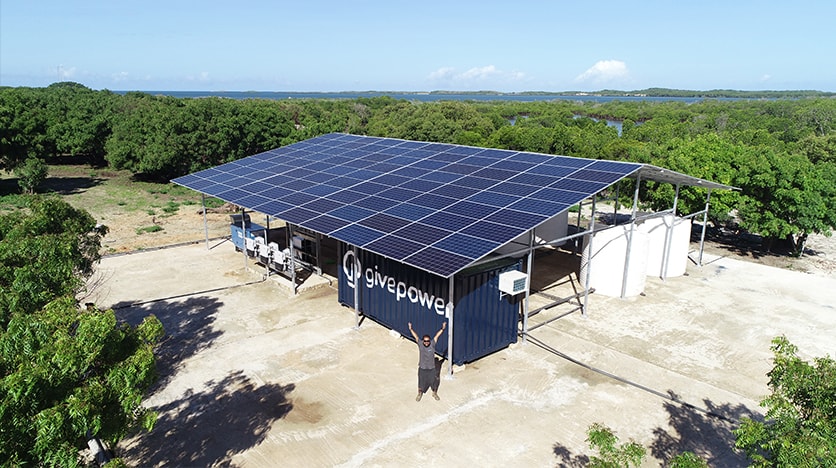From pv magazine USA.
GivePower is launching containerized, solar-powered water desalination and purification plants in Mombasa, Kenya and La Gonave, Haiti this quarter. Like GivePower’s debut solar-powered microgrid desalination plant, which went live in Kiunga, Kenya in 2018, these new projects will operate with Tesla’s powerwall battery storage technology.
At launch, both of the nonprofit’s new solar water farm projects will produce a maximum of 75,000 liters of water a day by coupling a 50-kW solar system with 120 kW-hrs of Tesla batteries; together this solar plus battery system will power two low-wattage, reverse osmosis desalination pumps that run simultaneously to ensure continuous operation.
When developing solar-powered desalination projects, pinning down the point at which the technology and the operating model make economic sense is key because the one of the biggest challenges with solar desalination is the amount of energy that it takes to desalinate sea water. Often, this outsized energy need means that a plant requires a larger solar array, which increases the cost of the project.
“We need to see that [these philanthropic] projects are economically viable – that these projects can continue to operate without ongoing funding from donors to keep the systems operational,” said Kyle Stephan, GivePower’s vice president of operations. In addition to building solar water farms, GivePower trains local technicians to operate the plants.
GivePower’s solar water farm systems cost just over $500,000, and they have a 20-year expected lifespan.
Commercial applications for GivePower’s solar water farm technology are not in the pipeline currently, according to Hayes Barnard, CEO of GivePower.
When it comes to developing commercial off-grid, solar-powered desalination systems for water-stressed communities, industry officials see solar microgrid players as particularly well placed to offer solutions.
Drought, saltwater intrusion and climate change are intensifying the need for solutions that use renewable energy to address water scarcity. Simultaneously, falling PV prices and energy storage innovations are making solar-powered desalination solutions more appealing.
So far, all of GivePower’s solar water farms are coastal well-based desalination plants. This is because 98% of the world’s water is in the ocean, and 73% of the world’s population live in coastal areas, where well water is susceptible to becoming brackish, Barnard noted. Additionally, off-coast solar desalination plants’ intake processes are expensive, and coastal well-based solar water farms do not stress underground aquifers.
For its project on La Gonave, which is off the coast of Port-au-Prince, GivePower is applying international building code seismic requirements for its solar water farm’s concrete foundation, and it is building a solar canopy that is capable of withstanding a category-four hurricane.
Initially, the nonprofit focused on providing solar-powered lighting to schools without electricity in the hope that this would open up educational opportunities for girls in developing countries. But quickly it became clear that helping communities achieve water security was key to addressing this issue because often girls were often missing school because their days were spent fetching water, according to Barnard, a GivePower co-founder. GivePower became an independent organization in 2016.
Last week GivePower’s solar-powered desalination technology received the UAE’s Global Water Impact Award for innovative small projects.
This content is protected by copyright and may not be reused. If you want to cooperate with us and would like to reuse some of our content, please contact: editors@pv-magazine.com.



Solarcity is a nonprofit? I could not verify that info. Please recheck.
Hi Cory, You are correct, this was a mistake in the lead intro. GivePower is a non-profit organization founded by SolarCity in 2013. SolarCity is a subsidiary of Tesla and is not a non-profit entity, at least not by design anyway!
Hi to all, I have been working on this project since 2006. SEAWATERNOSALT, regards Colin Mia Indy Green Energy RD UK